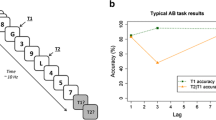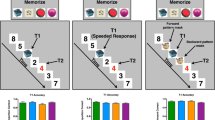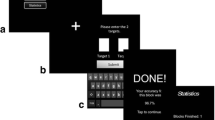Abstract
When the second of two targets is presented temporally close (within 500 ms) to the first target in rapid serial visual presentation, accuracy for reporting the second target is markedly diminished—an attentional blink (AB). The AB has become a well-studied phenomenon, and multiple different versions of the AB are currently in use. However, little is known about the stability of individual performance on the AB. The current study examined the reliability of two different versions of the AB task (a task-switch and no-task-switch version) within session, and over the period of 7–10 days, in order to examine performance stability. In addition to testing the reliability, we also examined the relationship between both versions of our AB tasks. Both versions of the AB were shown to be reliable within session, and over time, suggesting that performance is quite stable on this task. In addition, performance on the two different AB tasks was significantly correlated within and across sessions, suggesting that the AB phenomenon is being accurately captured by versions of the AB that include a task-switch. These findings are important given the recent interest in individual differences in performance on the AB.



Similar content being viewed by others
Notes
The same pattern of results was observed when the data scoring required participants to report the targets in the correct order.
The same pattern of results was observed when T2 sensitivity in the switch AB task was calculated using the sensitivity measure d’, with the exception that the relationship between the switch and no-switch AB size for session 1 fell just short of significance, due in part to one outlier.
Lags 2–4 were included in the short-lag estimate given that lags 2, 3, and 4 each had statistically lower T2 accuracy than the average T2 accuracy for the long lags (lags 7 and 8). Lag-1 also had lower T2 accuracy than the long lag average, but lag-1 T2 accuracy was not included in the short lag T2 accuracy estimate given that T2 accuracy at lag-1 is also influenced by the separate phenomenon of lag-1 sparing. However, the correlations with AB magnitude were also run where short lag accuracy was calculated using the average of lags 1–4 or the average of lags 2 and 3 only, and the same results were observed in each case.
AB magnitude is often calculated as the difference between long- and short-lag T2 accuracy, conditionalized on T1 correct. However, it is often difficult to assess the reliability of a difference score due to the fact that the reliability of the difference must necessarily be less than or equal to the reliability of each of the two values that are part of the subtraction. Our method isolates the lag-dependent effect that is the AB while controlling for individual differences in overall T2 ability that would otherwise confound the short-lag accuracy measure. However, we also note that the pattern of results was the same when an AB difference score was used.
References
Arnell, K. M., Howe, A. E., Joanisse, M. F., & Klein, R. M. (2006). Relationships between attentional blink magnitude, RSVP target accuracy, and performance on other cognitive tasks. Memory & Cognition, 34, 1472–1483.
Arnell, K. M., & Stubitz, S. M. (2009). Attentional blink magnitude is predicted by the ability to keep irrelevant material out of working memory. Psychological Research, 74, 457–467. doi:10.1007/s00426-009-0265-8.
Borgmann, K. W. U., Risko, E. F., Stolz, J. A., & Besner, D. (2007). Simon says: Reliability and the role of working memory and attentional control in the Simon task Psychonomic Bulletin and Review, 14(2), 313–319. doi:10.3758/BF03194070.
Colzato, S. L., Spape, M. M. A., Pannebakker, M. M., & Hommel, B. (2007). Working memory and the attentional blink: blink size is predicted by individual differences in operation span. Psychonomic Bulletin & Review, 14, 1051–1057.
Dale, G., & Arnell, K. M. (2010). Individual differences in dispositional focus of attention predict attentional blink magnitude. Attention, Perception, and Psychophysics, 72, 602–606. doi:10.3758/APP.72.3.602.
Dux, P. E., & Marois, R. (2009). The attentional blink: a review of data and theory. Attention, Perception, and Psychophysics, 71, 1683–1700. doi:10.3758/APP.71.8.1683.
Kelly, A. J., & Dux, P. E. (2011). Different attentional blink tasks reflect distinct information processing limitations: an individual differences approach. Journal of Experimental Psychology: Human Perception and Performance, 37(6), 1867–1873.
Klein, C., Arend, I. C., Beauducel, A., & Shapiro, K. L. (2011). Individuals differ in the attentional blink: mental speed and intra-subject stability matter. Intelligence, 39, 27–35.
Kunsti, J., Stevenson, J., Oosterlaan, J., & Sonuga-Barke, E. J. S. (2001). Test-retest reliability of a new delay aversion task and executive function measures. British Journal of Developmental Psychology, 19, 339–348.
MacLean, M. H., Arnell, K. M., & Busseri, M. (2010). Dispositional affect predicts temporal attention costs in the attentional blink paradigm. Cognition and Emotion, 24, 1431–1438. doi:10.1080/02699930903417897.
Martens, S., & Valchev, N. (2009). Individual differences in the attentional blink: the important role of irrelevant information. Experimental Psychology, 56, 18–26. doi:10.1027/1618-3169.56.1.1.
McLaughlin, E. N., Shore, D. I., & Klein, R. M. (2001). The attentional blink is immune to masking induced data limits. Quarterly Journal of Experimental Psychology, 54, 169–196. doi:10.1080/02724980042000075.
Nunnally, J. C. (1978). Psychometric Theory (2nd ed.). New York: McGraw-Hill.
Potter, M. C., Chun, M. M., Banks, B. S., & Muckenhoupt, M. (1998). Two attentional deficits in target search: the visual attentional blink and an amodal task-switch deficit. Journal of Experimental Psychology: Human Perception and Performance, 24, 979–992. doi:10.1037/0278-7393.24.4.979.
Raymond, J. E., Shapiro, K. L., & Arnell, K. M. (1992). Temporary suppression of visual processing in an RSVP task: an attentional blink? Journal of Experimental Psychology: Human Perception and Performance, 18, 849–860. doi:10.1037/0096-1523.18.3.849.
Stolz, J. A., Besner, D., & Carr, T. H. (2005). Semantic priming is robust but unreliable: inherent noise and strategic control in the activation and evaluation of semantic knowledge. Visual Cognition, 12, 284–336.
Acknowledgments
This work was funded by grants from the National Sciences and Engineering Research Council (NSERC), the Canadian Foundation for Innovation (CFI), and the Ontario Innovation Trust (OIF) to the second author.
Author information
Authors and Affiliations
Corresponding author
Rights and permissions
About this article
Cite this article
Dale, G., Arnell, K.M. How reliable is the attentional blink? Examining the relationships within and between attentional blink tasks over time. Psychological Research 77, 99–105 (2013). https://doi.org/10.1007/s00426-011-0403-y
Received:
Accepted:
Published:
Issue Date:
DOI: https://doi.org/10.1007/s00426-011-0403-y




